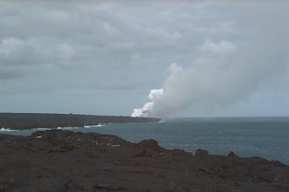|
Outpourings of magma can occur as a fluid-like lava
Figure 16.3 Hydrocholoric acid steam rises from the ocean as a Pu`u `O`o lava flow reaches sea water. Photo credit: M. Ritter Volcanic eruptions, especially explosive eruptions, eject
fragments of volcanic rocks and lava collectively called tephra
Volcanic eruptions are accompanied by the release of noxious and sometimes lethal gases. Steam makes up the majority of gas that is released by a volcano followed by carbon dioxide, sulfur dioxide, and hydrogen chloride. When lava spills into the ocean, the intense heating of salt water produces a noxious steam cloud of hydrochloric acid. Sulfur dioxide combines with water in the atmosphere to produce acid rain. Naturally produced acid deposition around the top of Mauna Loa has devastated the local vegetation. Warch USGS researchers collect lava sample near Pu`u `O`o in "Volcano Lava Sample" below.
Video: Volcanic Lava Sample |

